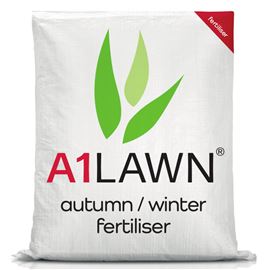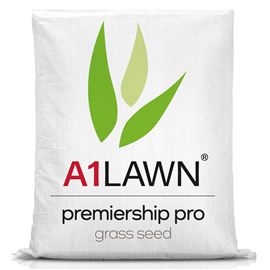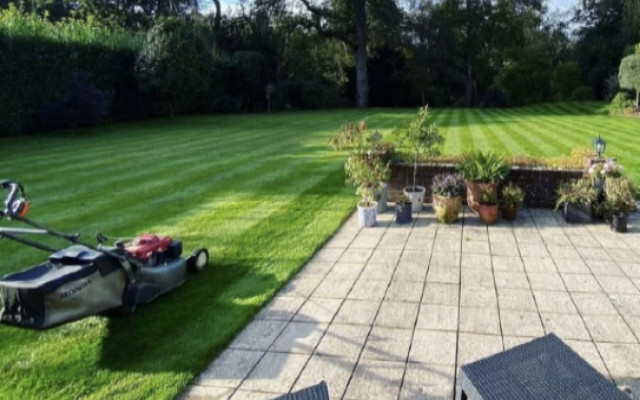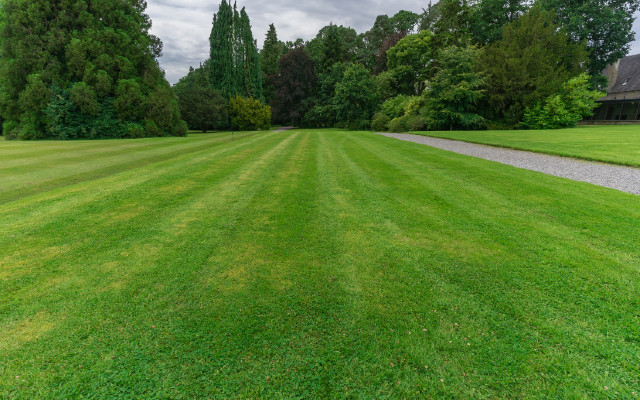When growing a new lawn from seed, the right preparation can usually deliver fantastic results, that are cheaper and easier than turf. At A1 Lawn our vast range of seed, including our AM Pro 24 Premiership Pro and AM Pro 26 Multi Purpose grass seeds, are all able to achieve high standards.
Timing
- Grass seed can be sown pretty much all year round but you should ensure that there is there is little to no chance of frost.
Most professional groundsmen and green keepers will tell you that early spring and autumn are the best times to sow new seed. Firstly because the soil temperature should be above the 7 degrees threshold that grass seed needs to germinate and, secondly, because there is plenty of moisture (rainfall) about in these periods
That doesn’t mean you can’t sow seed in the warmer months but it will mean that there might be a requirement for you to do more watering if it’s particularly dry or warm.
A frost doesn’t mean that you will lose all the seed, it could certainly reduce the percentage of germination and undermine all your hard work!
- The soil should not be too compacted at this stage and the top 1 to 2 inches needs to be worked to a fine tilth. The area also needs to be level and free of any weeds or large stones.
If you are using a pre-seed fertiliser, this needs to be put down around one week before the seed and, if there has been no rainfall, watered in to the area a couple of times. The 6-9-6 pre seed fertiliser is completely child/pet friendly so there are no real precautions that need to be taken once you’ve put it down but, as with any new area, the more that it can be left undisturbed, both through the preparation and early days of its growing life, the better the results.
You must keep the area moist as much as possible so, if there has been no rainfall for a couple of days, water the area using a fine spray (evenings are always best as this means you will lose the least amount of moisture to direct sunshine). If you choose the warmer months to sow seed then the area will need watered every evening if possible.
Sowing The Seed
A good tip to note as to how much seed to put down is to mark out a smaller area first and apply the relevant quantities to that area. This will give you a good visual guide as to what the desired distribution should look like. For example, most seed goes down at a rate of 35g/m2 (as does the fertiliser) so mark out a piece of ground 2m x 2m and then weigh out 4 x 35g of product and put it on the area. It’s worth noting at this point the products (ie. seed, fertiliser) should go down ‘as supplied’ and not mixed with any additional aggregates.
Once you have an even distribution of product, it needs worked in to the top 1-2 inches of soil. This is vitally important with the seed as it will greatly reduce any ‘bird take’ and it will also help the seed keep in contact with the soil and the moisture contained within it. A good way of doing this is by using the back of a rake and gently riddling the soil until the majority of the seed has disappeared into the surface.
At this stage, the area will benefit from some form of compaction. If you don’t have access to a roller then a good tip is to go over the area with a plank or similar wide board, putting down as much pressure as possible to compact the surface
Then Wait
- The seed can take anywhere between 7 – 21 days to germinate depending on soil temperatures and moisture levels. It can be frustrating waiting for this to happen but as long as you have followed the previous steps then it will germinate.
Just a case of leaving the area undisturbed for as long as possible (whilst keeping it moist). Give the new seed time to grow and establish as, the better chance you give it in its early development, the better results will be achieved in the long term.
When sowing a new area, it is almost impossible to avoid disturbing the odd seeds of weeds that have been lying dormant in the area and have been ‘woken up’ by the working of the topsoil. Again, don’t panic as these can be treated with a selective weed killer or granular weed, feed and moss killer at a later date.
It's First Cut
- When the new grass has reached a length of around 2-3 inches, it’s time to give it its first cut. The main thing to note at this point is not to cut it too short. Only take the top inch or so off the tips of the grass and leave plenty of growth as over cutting could seriously damage the new blades and lead to considerable die-back.
It is also worth noting at this point that there may still be some seed that is waiting to germinate. Over the coming weeks this will lead to the lawn becoming thicker and more lush, so it’s worth giving the area a bit of time before you consider over-seeding any bare patches.
Next Few Weeks
- If you have any pre-seed fertiliser left over then it will not go to waste. Giving the area added nutrients several weeks after its first germination will help promote the root system and lead to a healthier lawn in the long term.
If after several weeks there does appear to be barer patches, then this is usually down to slight variations in the level of the original seed bed or in the distribution of the seed itself. Don’t panic at this point as these areas can be easily over-seeded by spiking them and sowing new seed (again remembering to keep these areas moist).
If this is required then a good tip is to mix the seed with some top dressing or sand as this will give the seed something to hold moisture against and also lead to a more even distribution.



![A1 Lawn New Grass Pre-Seed and Pre-Turf Fertiliser [6-9-6] - 10KG](/prodimg/PRESEEDER-10KG_1_Medium.jpg)

